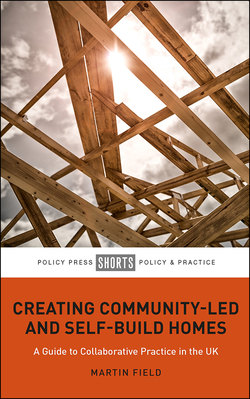Читать книгу Creating Community-Led and Self-Build Homes - Field Martin - Страница 7
На сайте Литреса книга снята с продажи.
ОглавлениеIntroduction: people providing homes for themselves in the UK
This is a book about people in the UK taking charge of their own homes. At a time when there is so much dissatisfaction with the kinds of homes (and their condition) available for sale or rent in the UK, the publication sets out to explain the ways people have wished to house themselves, in places of their own choosing and their own designs.
The following chapters provide a framework to analyse what people have been doing in a wide variety of activities – as individuals, in groups, or on behalf of their local communities – to create homes that can satisfy many kinds of ambition:
Source: © M. Field 2019
The UK’s housing sector is increasingly full of uncertainties regarding how people can find and maintain a satisfactory home in which they can thrive. Headline reports routinely note the diminishing control many households have on their domestic circumstances – fewer and fewer households in owner-occupation; rising numbers forced to live in accommodation provided by an uncompromising private rented sector; and prolonged time spent by young adults living in the parental home.
There are also competing debates at national and international levels on the ends to which modern housing provision could or should be tailored – whether its primary function remains the asset basis for a welfare provision that can deliver affordable housing to households unable to find other suitable accommodation, or if it should be focused upon real estate investment to stimulate wider property-based wealth within local communities.
A brief summary of how the UK’s housing sector plans for the construction of homes and delivery of neighbourhood services would include the following observations:
•The UK’s present culture of housing provision is a tried and tested framework for mainstream participants to plan and provide housing and neighbourhood services.
•It is intrinsic to the nature of the UK’s ‘open market’ practices that, notwithstanding some occasional innovation, existing relationships remain unchanged until dominant interests accept reasons to change.
•Ideas for new forms of, or gaps in, housing provision are best assessed and addressed by the experienced partnerships and frameworks already in place – the extent of any local demand (such as represented by community-led housing solutions) is not proven, or will only be present on a very modest scale.
•The established networks which interact on land, finance and construction services are not ones in which ‘community’ projects can easily compete – proposals for solutions from the grassroots of local communities are not seen to have the governance skills or practical expertise to drive new projects forward.
This publication centres around the nature and ways in which the individual and collaborative actions of people in the UK have sought to challenge the above positions. An underlying theme is an awareness of the tension between how local people can obtain lasting and secure homes and neighbourhoods at affordable costs and how there should be accountability to local communities and their local residents for the homes and places created. What follows are extensive descriptions of the innovative responses of local people to achieve the homes and neighbourhoods that can meet their personal and collective ambitions, plus ideas on the kinds of benchmarks for how the public, private and community sectors might be accommodating of such activities.
